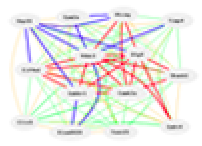| |
|
|
|
|
|
|
|
|
|
|
|
|
Welcome! Login
|
|
Data Set Group2: GSE11882 UCI Human Affy U133 Plus2 (Sep13) RMA

|
|
| Contact Information |
Nicole Claudia Berchtold
University of California, Irvine
1226 Gillespie Neuroscience Facility
Irvine, CA 92697-4540 USA
Tel. 949 824 6071
nberchto@uci.edu
Website
|
| Download datasets and supplementary data files |
|
|
|
|
| Specifics of this Data Set: |
None
|
| Summary: |
| Gene expression profiles were assessed in the hippocampus (HC), entorhinal cortex (EC), superior frontal gyrus (SG), and postcentral gyrus (PCG) across the lifespan of 63 cognitively intact individuals from 20-99 years old. New perspectives on the global gene changes that are associated with brain aging emerged, revealing two overarching concepts. First, different regions of the forebrain exhibited substantially different gene profile changes with age. For example, comparing equally powered groups, 5,029 probe sets were significantly altered with age (20-59 vs. 60-99) in the superior frontal gyrus, compared with 1,110 in the entorhinal cortex. Prominent change occurred in the 6th-7th decades across cortical regions, suggesting that this period is a critical transition point in brain aging, particularly in males. Second, clear gender differences in brain aging were evident across the lifespan, suggesting that the brain undergoes sexually dimorphic changes in gene expression not only in development but also in later life. Globally across all brain regions, males showed more gene change than females. Further, Gene Ontology analysis revealed that different categories of genes were predominantly affected in males vs. females. Notably, the male brain was characterized by global decreased catabolic and anabolic capacity with aging, with downregulated genes heavily enriched in energy production and protein synthesis/transport categories. Increased immune activation was a prominent feature of aging in both sexes, with more widespread activation in the female brain. These data open new opportunities to explore age-dependent changes in gene expression that set the balance between neurodegeneration and compensatory mechanisms in the brain, and suggest that this balance is set differently in males and females, an intriguing and novel idea. HgU133plus2.0 microarray chips were used to profile gene expression in 4 brain regions of cognitively intact humans, across the adult lifespan (ages 20-99).
|
| About the cases used to generate this set of data: |
|
| About the tissue used to generate this set of data: |
|
| About the array platform: |
|
| About data values and data processing: |
|
| Notes: |
|
| Experiment Type: |
| Postmortem brain tissue was collected from ADRC brain banks. Cases were preferentially selected where 3 or more brain regions were available.
|
| Contributor: |
| Berchtold NC, Cribbs DH, Coleman PD, Rogers J, Head E, Kim R, Beach T, Miller C, Troncoso J, Trojanowski JQ, Zielke HR, Cotman CW
|
| Citation: |
| Berchtold NC, Cribbs DH, Coleman PD, Rogers J et al. Gene expression changes in the course of normal brain aging are sexually dimorphic. Proc Natl Acad Sci U S A 2008 Oct 7;105(40):15605-10. PMID: 18832152
|
| Data source acknowledgment: |
|
| Study Id: |
175
|
|
|

|
Web services initiated January, 1994 as Portable Dictionary of the Mouse Genome; June 15, 2001 as WebQTL; and Jan 5, 2005 as GeneNetwork.
This site is currently operated by
Rob Williams,
Pjotr Prins,
Zachary Sloan,
Arthur Centeno. Design and code by Pjotr Prins, Zach Sloan, Arthur Centeno, Danny Arends, Christian Fischer, Sam Ockman, Lei Yan, Xiaodong Zhou, Christian Fernandez, Ning Liu, Rudi Alberts, Elissa Chesler, Sujoy Roy, Evan G. Williams, Alexander G. Williams, Kenneth Manly, Jintao Wang, and Robert W. Williams, colleagues.
|

|

|
GeneNetwork support from:
- The UT Center for Integrative and Translational Genomics
- NIGMS Systems Genetics and Precision Medicine project (R01 GM123489, 2017-2021)
- NIDA NIDA Core Center of Excellence in Transcriptomics, Systems Genetics,
and the Addictome (P30 DA044223, 2017-2022)
- NIA Translational Systems Genetics of Mitochondria, Metabolism, and Aging (R01AG043930, 2013-2018)
- NIAAA Integrative Neuroscience Initiative on Alcoholism (U01 AA016662, U01 AA013499, U24 AA013513, U01 AA014425, 2006-2017)
- NIDA, NIMH, and NIAAA (P20-DA 21131, 2001-2012)
- NCI MMHCC (U01CA105417), NCRR, BIRN, (U24 RR021760)
|
|
It took 0.047 second(s) for tux01.uthsc.edu to generate this page
|
|







